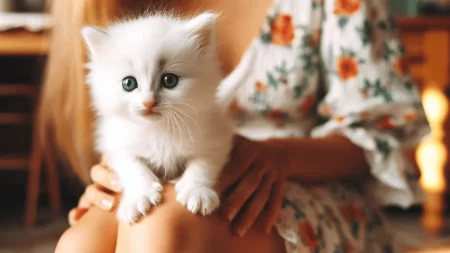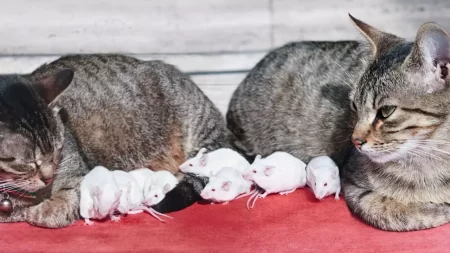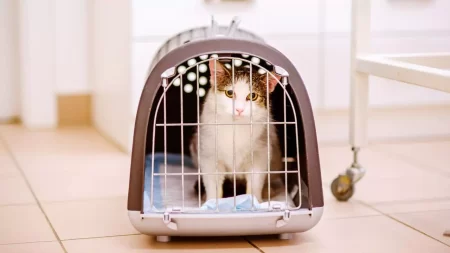Have you ever wondered why cats meow? Is it just to get attention? Or is there a deeper meaning behind their mews? In this blog, we’ll explore the mysterious world of cats and why they make that curious sound. So grab your favorite pet, curl up in your favorite chair, and let’s dive into the wonderful (and sometimes mysterious!) world of cats.
Cats are incredibly vocal animals, capable of making a variety of sounds to communicate their needs and desires. While they may hiss, purr, growl, yowl, or even chirp at times, cats are perhaps best known for their iconic meow.
The reasons cats meow can vary widely based on the situation and the individual cat in question. From greeting people to making demands for food or attention, there are many potential explanations as to why your feline friend might be meowing away. Understanding when and why cats meow can help you recognize your cat’s needs so that you can provide a safe and comfortable environment for them. This guide will examine the reasons why cats meow so you can better understand your furry companion’s behavior.
History of Cat Meowing
Cat communication dates back thousands of years and meowing is believed to be a form of cat-to-human communication, as cats did not meow to one another prior to their domestication. It’s believed that cats learned this behavior in order to communicate with humans – and it worked!
It’s possible that cats adopted the instinctive meow sound from their ancient wildcat ancestors, as wildcats still ‘meow’ at humans today. It has also been suggested that meowing could have been passed down through cat generations, by way of reinforcement from their human carers. As kittens naturally meow to their mothers for food, love, and attention – it is possible for them to recognize this behavior works with humans too.
Cats may also use different tones and inflections in the meows they use during different instances within their lives, from birth up until adulthood. They may also purr or mew when they feel happy or contented, as well as during times when they are feeling stressed or anxious. In some situations, cats might use a short mew or trill along with other body languages such as pawing or rubbing up against a person. This type of communication is different from what cats would use when speaking to another feline friend but meowing remains an effective way for them to signal something to us humans.
Reasons Cats Meow
Cat meowing is a form of communication that can mean many different things. Understanding the reasons behind your cat’s meows can help you better respond and meet their needs.
Cats may meow as a way of greeting their owners—a sign of affection and recognition. When your cat sees you, it may meow to get your attention or show excitement. You may also notice that your cat greets you with extended meows or trills if they are particularly excited.
Kittens generally meow in order to communicate with their mothers, especially when they are hungry or need assistance. As cats become older, they continue to use meowing as an important means of communication. Cats will often meow in response to humans in order to solicit attention or food, for example, if your cat begs for treats by asking with soft chirps and mews.
Other reasons cats will meow include when they’re feeling anxious, such as during times of transition like moves or family changes, or when they experience health issues like pain – this type of vocalization may sound more distressed than regular mewing. Vocalizations can also indicate stress due to environmental changes like introducing a new pet into the home, so keep an eye out for signs that your pet is distressed both physically and emotionally so that you can take action and make sure their needs are being met.
Different Types of Meows
Different cats meow in different ways and for a variety of reasons. Some cats may meow to get attention or as a sign of affection while others may meow to get food or water. Learning your cat’s individual type of meow can help you understand what they need, and give them the love, attention, and resources that they require.
Kittens generally use the highest-pitched meows when seeking attention from their mother or humans. Older cats tend to have a lower-pitched mew that implies more urgency. A cat’s individual vocalizations can range from short exclamations to drawn-out multi-syllabic sounds and many tones in between.
The “airplane” meow is characterized by a drawn-out repetitious snaking through many stages of the pitch before ending with a sigh. This is usually used when seeking attention from their owner or an invitation to be petted by a stranger.
The “slow blink” meow is often used by senior cats because it gets across their affectionate side without expending too much energy. It starts with one long low-pitched mew, ending with two higher notes at the end like they are saying “ah…mah!”
The chirp is often used when they feel like something exciting will happen soon! A brief high-pitched chirping sound that creeps up in pitch as it runs through its syllables, indicates happiness and anticipation for whatever is about to come next – maybe treats, cuddles, or playtime?
This variation on the momma cat signature trill usually rises in pitch throughout its run before ending in either an upwards turn (happy) or a downward turn (cautious). This one suggests contentment but needs confirmation from other body language indicators such as purring, relaxed posture, or grooming motions – let your cat take the lead here!
How to Interpret Cat Meows?
Cats meow for many reasons—to say hello, to ask for things, and to tell us when something’s wrong. Hence, it’s important to understand why cats meow in order to properly interpret your cat’s behavior and ultimately develop a better relationship with your pet. Generally speaking, there are three different types of meows: the greeting meow, the demanding meow, and the habituated meow. It’s important to understand the differences so that you can effectively respond to each type of vocalization.
Greeting meows are used when cats want attention from people or animals they know. Generally, they are soft affirmations given back and forth as a polite way of saying “hello”. When you return your cat’s greeting by talking or gently petting them they usually become very affectionate and content.
Demand meows are used when cats make requests of people they know, such as asking for food or wanting attention or access to closed doors or inaccessible places. This type of vocalization is usually louder than their greeting vocalizations and often accompanied by aggressive body language such as pawing at whatever it is they desired (including you). The best way to respond is by firmly reiterating that you belong in control of the situation–do not give in until you have responded adequately enough that the cat understands it must obey what you require before being allowed what it desires.
Habituated meowing–sometimes referred to as neurotic behavior–is often accompanied by obsessive behavior such as pacing back and forth along a set path or incessant vocalizations for no apparent reason other than boredom or anxiety. These behaviors can be corrected by providing more stimulation through play with toys or engaging in activities like chasing lasers; these should be done several times per day in varied sequences so that the behavior doesn’t become monotonous for your cat–cats get quickly bored with repetition! Additionally, provide hiding spots where it will feel safe (a box under a bed is ideal), talk reassuringly while stroking its fur if necessary, and make sure there are no other stressors present like loud noises outside or too many unfamiliar visitors coming through the home on a regular basis.
Health Reasons for Cat Meowing
Cats meow for a variety of reasons and it is important to be able to recognize when your cat is trying to communicate something to you. Although cats typically meow as a way of communicating with their human guardians, they can also meow if they are in distress or feeling ill.
The list below outlines some potential health-related causes of meowing in cats:
Hunger
Cats may vocalize when they are hungry and want food. If your cat starts meowing more frequently than usual, check to see if she needs to be fed.
Illness
Pain caused by sickness or injury can cause a cat to meow more often than normal. It’s important for pet owners to pay close attention if their cats start exhibiting excessive vocalization as it could signal that the cat is not feeling well and needs medical treatment from a veterinarian.
Aging
Older cats are especially prone to various ailments, such as arthritis and kidney disease, which can result in increased vocalization due to discomfort or pain. If your older cat suddenly starts displaying increased vocalization, it is important for them to see the vet for an examination as soon as possible.
Stress/Anxiety
Stressful situations can lead some cats to begin vocalizing more often than usual. Loud noises such as thunderstorms, fireworks displays, or house renovations can all cause anxiety in felines that could result in more frequent meowing. If your cat is experiencing stress due to environmental factors, treatments such as Feliway diffusers and Calm Chews may help reduce his stress levels.
What to Do When Your Cat Meows Excessively
Cats meow for a variety of reasons, but excessive meowing can be a sign that something is wrong. If you think your cat is meowing more than usual, it is important to pay attention to when and why they are vocalizing.
When cats meow excessively, it can indicate an underlying medical issue such as hyperthyroidism or stress and anxiety. In such cases, it is best to take your cat to the vet right away so it can receive an accurate diagnosis and the proper treatment. Additionally, if a new animal or person enters the home, this may trigger increased vocalization.
If a medical cause has been ruled out by your veterinarian, then it could be beneficial to try some behavior modification techniques at home. Start by addressing specific unwanted behaviors rather than merely trying to reduce meowing overall. For instance, if your cat is meowing excessively during meal times or when you leave the house for work, then try consistently rewarding/positively reinforcing calm behavior instead of responding negatively when loud vocalization occurs. You may also want to consider changing their environment and providing them with more mental stimulation through interactive play sessions or puzzle feeders filled with treats. This can help keep their mind active and help reduce stress-related behaviors which often manifest as excessive vocalization.
Conclusion
After considering the various possible explanations for why cats meow, it appears that they do so primarily as a form of communication with their owners. In many cases, cats seem to use meowing as a way to ask for something or let their owners know that they are in need of attention, food, water, or affection. Cats also appear to meow in response to other cats, forming bonds and communication within the feline world.
Some behavioral researchers have also put forth the idea that cats evolved complex vocalizations in order to appeal to humans and better ensure recognition and care. Additionally, some cats may meow simply out of boredom or even as a sign of distress due to environmental changes or health issues.
Ultimately, while there is still some mystery surrounding feline vocalizations, it is thought that your cat’s meow is simply an expression designed by Mother Nature after thousands of years spent living in close proximity to humans.




![Why Do Cats Meow? [Definition, History and Reasons] Why Do Cats Meow](https://justcatlover.com/wp-content/uploads/2022/12/Why-Do-Cats-Meow-1024x576.jpg)


